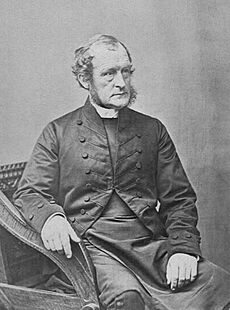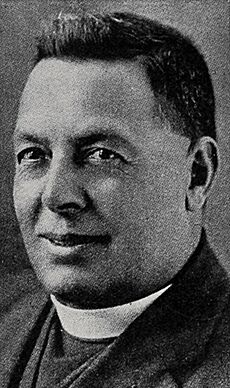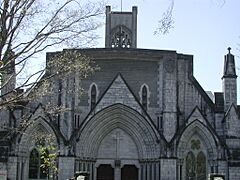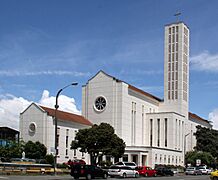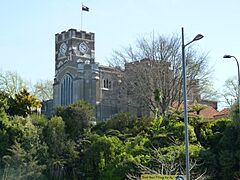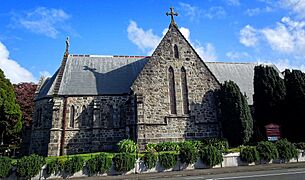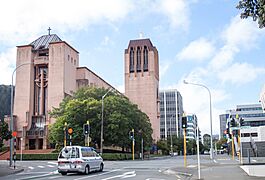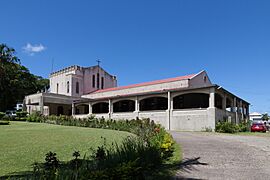Anglican Church in Aotearoa, New Zealand and Polynesia facts for kids
Quick facts for kids Anglican Church in Aotearoa, New Zealand and Polynesia |
|
|---|---|
| Te Hāhi Mihinare ki Aotearoa ki Niu Tīreni, ki Ngā Moutere o Te Moana Nui a Kiwa | |
 |
|
| Classification | Western Christian (with various theological and doctrinal identities, including Anglo-Catholic and Evangelical) |
| Orientation | Anglican |
| Scripture | Holy Bible |
| Theology | Anglican doctrine |
| Polity | Episcopal |
| Primates (Archbishops) |
Don Tamihere (Aotearoa) Vacant (New Zealand) Sione Uluʻilakepa (Polynesia) |
| Dioceses | 13 |
| Parishes | 552 (2008) |
| Region | New Zealand, Fiji, Tonga, Samoa, and the Cook Islands |
| Headquarters | Meadowbank, Auckland, New Zealand |
| Separations | Church of Confessing Anglicans of Aotearoa/New Zealand (2019) |
The Anglican Church in Aotearoa, New Zealand and Polynesia is a Christian church. It is part of the worldwide Anglican Communion. This church serves people in New Zealand, Fiji, Tonga, Samoa, and the Cook Islands.
Since 1992, the church has been organized into three main cultural groups. These groups are called tikanga. They are Aotearoa (for Māori people), New Zealand (for people of European heritage), and Polynesia (for Pacific Islanders). The church believes everyone should be able to express their faith in their own culture.
Because of this, the church has three leaders, called primates or archbishops. Each leader represents one of the tikanga groups. They share authority in leading the church.
The Anglican Church is an old church. It traces its bishops back to the first apostles of Jesus. The main book for worship is A New Zealand Prayer Book, He Karakia Mihinare o Aotearoa. It contains prayers, services, and blessings.
Unlike the Church of England, this church is not the official church of any government. However, Anglican leaders often play an important role in New Zealand's national events. In 2018, Anglicanism was the largest Christian group in New Zealand. There were 314,913 Anglicans recorded in the census.
Contents
Names of the Church
Before 1992, the church was known as the "Church of the Province of New Zealand". It was also sometimes called the "Church of England". Now, it is called the "Anglican Church". This name shows it is part of the global Anglican Communion. People who belong to this church usually call themselves "Anglicans".
The Māori name for the church is Te Hāhi Mihinare. This means "the missionary church". It shows how the church started with the first missionaries in New Zealand.
History of the Church
Early Anglicans in New Zealand
The Church Missionary Society (CMS) started its work in New Zealand in 1799. This group wanted to help improve how indigenous people were treated by the British.
Samuel Marsden, an Anglican chaplain from Australia, began the CMS mission in New Zealand. He met Māori chiefs Te Pahi and Ruatara. They invited him to visit their country. Ruatara helped protect the first mission station in the Bay of Islands.
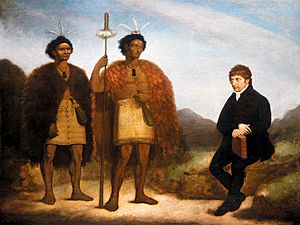
At first, wars between Māori tribes made it hard for missionaries to travel. Also, some missionaries got involved in trading, which caused problems.
The Māori language did not have a written form. Missionaries learned to speak Māori. They helped create a written language using the Latin alphabet. People like Thomas Kendall and Māori chiefs Tītore and Hongi Hika worked with Cambridge University's Samuel Lee. They developed the written language between 1817 and 1830.
In 1833, the first books were printed in New Zealand. These were Māori translations of parts of the Bible. In 1837, the Māori New Testament was published. This was the first Bible translation in an indigenous language in the Southern Hemisphere. Many Māori wanted to read the New Testament and the Prayer Book. Soon, 33,000 Māori regularly attended Christian services. Being able to read and understand the Bible helped Māori society. It increased peace and respect for all people.
Missionaries and the Treaty of Waitangi
Māori generally respected the British. This was partly because of their connections with missionaries. The British were also a powerful sea nation. In England, the church and government were closely linked. Anglican missionaries encouraged Māori to seek protection from the British Crown.
Because of this, CMS missionaries, especially Henry Williams, helped Māori sign the Treaty of Waitangi in 1840. This treaty was an agreement between the British Crown and Māori chiefs.
Henry Williams and his son, Edward Marsh Williams, translated the treaty into Māori. They wanted to make sure the treaty was fair to Māori. They used Māori words from the Bible to explain ideas like kawanatanga (governorship) and rangatiratanga (chiefly rule). The idea of the treaty as a "covenant" also came from the Bible.
Later, Māori became disappointed. The colonial government often ignored the treaty. This led some Māori to create their own religious movements.
The Settler Church
Many Anglican settlers arrived in New Zealand in the mid-1800s. Most came from England, some from Ireland and Australia. Because of these settlers and the early missionary work, Anglicanism became the largest religion in New Zealand. In 1858, more than half of the colony's people were Anglican.
George Augustus Selwyn became the Bishop of New Zealand in 1841. He led both the Māori and settler parts of the church. Some missionaries did not like his control. Settlers were sometimes unhappy with his support for Māori. He often found himself caught between Māori and Pākehā issues, especially about land.
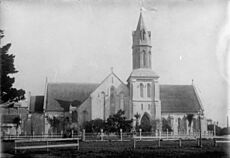
The first Anglican church in Auckland was St Paul's. It was founded in 1841. It is known as the 'Mother Church' of Auckland. St Paul's was Bishop Selwyn's main church for 28 years. It served as Auckland's Cathedral for over 40 years.
Bishop Selwyn opened St Paul's Church on May 7, 1843. He wrote that Māori people traveled long distances to be there. They wore European clothes and joined in the service. St Paul's held four services every Sunday. Two were in te reo Māori and two in English. Bishop Selwyn learned te reo Māori himself.
The CMS criticized Selwyn for not training enough Māori clergy. It took him 11 years to ordain the first Māori Anglican minister, Rev Rota Waitoa, in 1853. Selwyn later ordained seven more Māori clergy. However, his traditional ways were seen as hurting Māori interest in Christianity.
Selwyn often supported Māori rights. He spoke out against unfair land practices that led to the New Zealand Wars. However, his support for the Invasion of the Waikato as a chaplain damaged his and the church's relationship with Māori. This impact is still felt today.
Church Organization
Anglicans in New Zealand wanted to organize their church. They needed a way to do this since they were not the official state church. In 1857, after 15 years, a constitution was created. It was based on a voluntary agreement. This constitution ensured that the church kept its traditions from England in worship and beliefs. Bishops, clergy, and ordinary church members met and voted separately on church matters. This gave each group an equal voice.
Regional Churches
Bishop Selwyn's large diocese was divided into smaller areas. Christchurch became a new diocese in 1856. Wellington, Nelson, and Waiapu followed in 1858. Dunedin separated from Christchurch in 1869.
Each diocese developed its own unique character. For example, the Christchurch diocese was shaped by English settlers. Waiapu had strong missionary beginnings. Its first church conferences were held in Māori language.
20th and 21st Centuries
Even though Māori were a large part of the Anglican church, calls for a Māori bishop were not heard for a long time. Bishop Selwyn believed that only those trained in Greek and Latin languages could be bishops.
After many years of requests, the first Pīhopa o Aotearoa (Bishop of Aotearoa), Frederick Bennett, was made a bishop in 1928. This happened partly because of fears that more Māori would leave the church.
By 1936, the number of Anglicans in New Zealand had dropped to 40% of the population. This number continued to fall from the mid-1960s. In the 2018 census, 314,913 people in New Zealand identified as Anglican. It was the second largest religious group after Catholicism.
The number of people who attend church regularly is much smaller. Only about one in ten New Zealanders who identify as Christian attend services often.
In areas where there were not enough church members to pay a priest, local people or self-supporting priests took on ministry tasks.
A New Zealand Prayer Book, He Karakia Mihinare o Aotearoa, was published in 1989. It was updated in 2020 to include more Māori and other Pacific languages.
In 1992, the church adopted a new constitution. This introduced the tikanga system. This system organizes the church into three cultural streams.
Church Leadership
The Anglican Church has decided that three bishops will share the role of Primate and archbishop. Each represents one of the three tikanga groups. These are the three bishops who currently share this title:
- Don Tamihere, who leads Te Pīhopatanga o Aotearoa for the Māori people of Aotearoa New Zealand.
- The Senior Bishop of the New Zealand dioceses. This position has been vacant since July 1, 2023. This bishop oversees dioceses for Pākehā (people of European heritage).
- Sione Uluʻilakepa, the Bishop of Polynesia. He oversees the Diocese of Polynesia for the Oceania region.
The Tikanga System
Aotearoa Tikanga
Te Pīhopatanga o Aotearoa is one of the three tikanga. It oversees churches for the Māori people of Aotearoa. Aotearoa has five pīhopatanga or regional bishoprics. Each is led by te pīhopa o...:
- Tairāwhiti (meaning "east coast")
- Tai Tokerau (meaning "north coast")
- Upoko o Te Ika (meaning "the head of the fish", which is the southern North Island)
- Waipounamu (meaning "greenstone waters", which is the South Island)
- Manawa o Te Wheke (meaning "the heart of the octopus", which is the central North Island)
New Zealand Tikanga
The New Zealand tikanga has seven dioceses:
- Auckland
- Christchurch
- Dunedin
- Nelson
- Waiapu
- Waikato and Taranaki
- Wellington
The dioceses in New Zealand are led by a "senior bishop". This bishop is chosen from among the leaders of the dioceses. This Senior Bishop is also a Primate and Archbishop for the whole church. The position has been vacant since June 2023.
- Cathedrals
-
Holy Trinity Cathedral in Parnell, Auckland
-
"Cardboard Cathedral", the pro-cathedral of Christchurch
-
St Paul's Cathedral in Dunedin
-
Christ Church Cathedral in Nelson
-
Cathedral of St John the Evangelist in Napier
-
St Peter's Cathedral in Hamilton
-
Taranaki Cathedral, Church of St Mary, in New Plymouth
Polynesia Tikanga
The Diocese of Polynesia, also called the Tikanga Pasefika, serves Anglicans in Fiji, Tonga, Samoa, and the Cook Islands. The first bishop for this diocese was appointed in 1908. The main church for the diocese is Holy Trinity Cathedral in Suva, Fiji. The Bishop of Polynesia is automatically a Primate and Archbishop. Sione Uluʻilakepa has been the bishop since 2023.
-
Diocese Of Polynesia Holy Trinity Cathedral in Suva, Fiji
Ministry in the Church
The Anglican Church has three main roles for its leaders: deacon, priest (or presbyter), and bishop. The church emphasizes that these roles should work together. They should also work with all the people of God in the church.
Training for Ministry
People who want to become clergy usually train at St John's College, Auckland. This college also follows the three tikanga approach. Other colleges like Selwyn College, Otago and College House used to train clergy. Now, these colleges are mainly homes for university students.
Worship and Services
A New Zealand Prayer Book, He Karakia Mihinare o Aotearoa, is very important to the church's worship. It has a calendar for church seasons. It also includes daily prayers, services for baptism, and Holy Communion (also called the Eucharist). The book also has texts for weddings, funerals, and ordinations. It also has a catechism to teach about the faith.
The book was first published in 1989. It was special because it used local texts and Māori language. A new edition in 2020 added more Māori and other Pacific languages.
The church also allows the use of older versions of the Book of Common Prayer from the Church of England. Other prayer books from the Anglican Communion can also be used.
Social Issues
Women in Leadership
The Anglican Church in Aotearoa, New Zealand and Polynesia has allowed women to be deacons and priests since 1977. Women have been allowed to be bishops since 1988. Penny Jamieson was the Bishop of Dunedin from 1990 to 2004. She was the first Anglican woman bishop in the world to lead a diocese. Wai Quayle became the first indigenous woman bishop in 2019.
See Also
 In Spanish: Iglesia anglicana en Aotearoa, Nueva Zelanda y Polinesia para niños
In Spanish: Iglesia anglicana en Aotearoa, Nueva Zelanda y Polinesia para niños
- Christianity in New Zealand
- Christianity in Fiji



